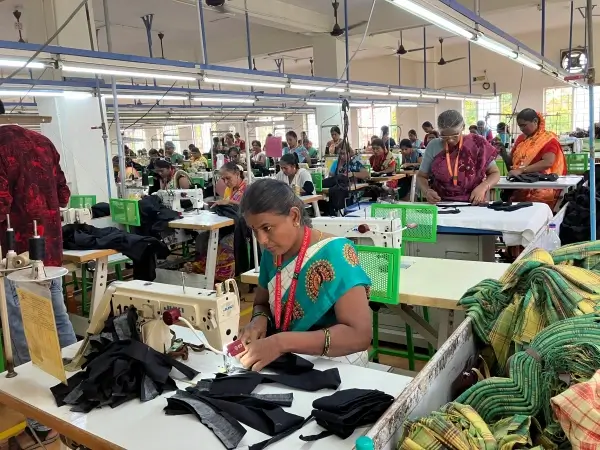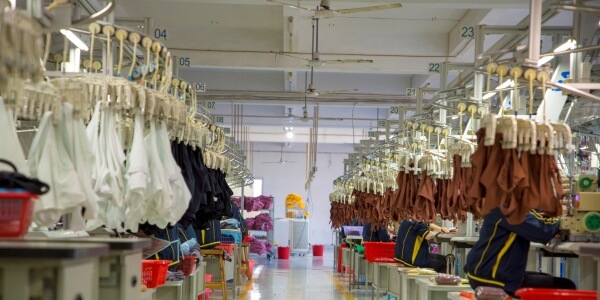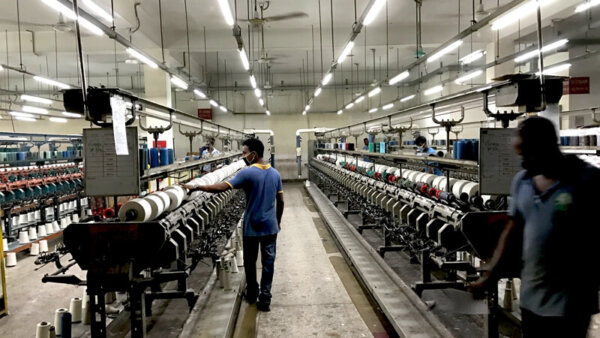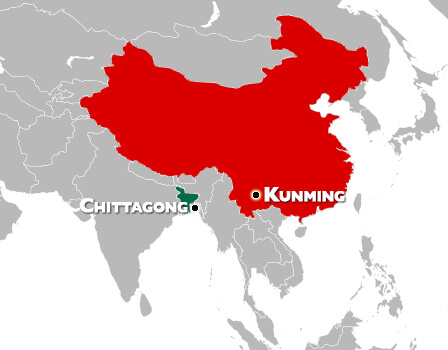لماذا يجب أن يكون لمصنعي الملابس الداخلية قدرات إنتاج في كل من الصين وجنوب شرق آسيا؟
في بيئة التجارة العالمية المتقلبة اليوم ، يواجه مصنعو الملابس الداخلية تحديات غير مسبوقة. تهدد التعريفات المتزايدة ، والتوترات الجيوسياسية ، وتعطيل سلسلة التوريد الاستقرار والربحية للشركات التي تعتمد على إنتاج البلدان الواحدة.
تتمثل الاستراتيجية المثلى لمصنعي الملابس الداخلية في الحفاظ على قدرات الإنتاج المزدوجة في كل من الصين وجنوب شرق آسيا. يستفيد هذا النهج من خبرات التوريد والتوريد الكاملة في الصين مع الاستفادة من مزايا التعريفة في جنوب شرق آسيا وخفض تكاليف العمالة ، مما يخلق مرونة ضد عدم اليقين التجاري وزيادة المزايا التنافسية.

بصفتي مؤسس شركة Have ، وهي شركة رائدة في مجال المصنعين للملابس الداخلية ومقرها في مدينة Gurao ، مدينة Shantou ، شاهدت بشكل مباشر كيف أعاد المشهد التجاري المتغير تشكيل صناعتنا. أجبرت التوترات التجارية الأمريكية الصينية العديد من الشركات المصنعة على إعادة النظر في استراتيجيات الإنتاج الخاصة بهم. اسمحوا لي أن أشارك لماذا اعتمدنا نهج الإنتاج المزدوج وكيف يستفيد من أعمالنا وعملائنا.
لماذا لا تزال الصين ضرورية لتصنيع الملابس الداخلية على الرغم من ارتفاع التعريفات؟
خلقت عدم اليقين في العلاقات التجارية بين الولايات المتحدة الصينية تحديات كبيرة لمصنعي الملابس الداخلية. رفعت التعريفات المتزايدة التكاليف ، والوهام المقطوعة ، وعطلت نماذج الأعمال المعروفة التي تعتمد بشكل حصري على الإنتاج الصيني.
لا تزال الصين ضرورية لتصنيع الملابس الداخلية بسبب سلسلة الصناعية الكاملة التي لا مثيل لها ، والتكنولوجيا المتقدمة ، والقوى العاملة الماهرة ، وقدرات تطوير المنتجات المتفوقة. تتيح هذه المزايا أسرع وقت إلى السوق ، ومعايير الجودة العالية ، والتصميمات الأكثر إبداعًا التي لا يمكن تكرارها بسهولة في مكان آخر.

في الحصول على مرفق Shantou الخاص بنا ، يمثل تتويجًا لعقود من الخبرة في تصنيع الملابس الداخلية. توفر لنا المجموعة الصناعية في مدينة Gurao وصولًا فوريًا إلى كل ما نحتاجه - من الأقمشة المتخصصة والقطن إلى صانعي الأنماط الماهرة وفنيي عينة. يتيح لنا هذا النظام الإيكولوجي الكامل تطوير منتجات جديدة بسرعة ودقة رائعة.
When we receive a design concept from a European or American client, we can transform it into a physical sample within days, not weeks. This rapid development cycle is possible because all necessary components and expertise are within reach. Our technicians have spent years perfecting techniques for creating comfortable, aesthetically pleasing underwear that follows our "body-before-fabric" فلسفة.
تتركز المعرفة المتخصصة المطلوبة لإنتاج المنتجات المستعبدة عالية الجودة بشكل خاص في الصين. تتطلب تقنية الترابط ، التي تقضي على طبقات تقليدية من أجل صورة ظلية أكثر سلاسة ، معدات متخصصة وخبرة فنية تم تنقيحها في مرافق Shantou لدينا على مدار سنوات عديدة. تعد هذه التكنولوجيا أمرًا بالغ الأهمية لإنشاء ملابس داخلية حديثة ومريحة وحمالات الصدر السلس التي تلبي المعايير الصعبة لعملائنا الدوليين.
علاوة على ذلك ، تدعم البنية التحتية للتصنيع في الصين إنتاجًا كبيرًا على نطاق واسع مع مراقبة ثابتة للجودة. يمكن لمصنعنا في شانتو إنتاج آلاف القطع يوميًا مع الحفاظ على معايير جودة صارمة عبر خطوط الإنتاج الواسعة لدينا ، بما في ذلك حمالات الصدر والسراويل الداخلية والملابس الأصلية وملابس السباحة. يمكنك معرفة المزيد عن عمليات مراقبة الجودة لدينا على صفحة مراقبة الجودة.
كيف تكمل جنوب شرق آسيا الصين في معادلة تصنيع الملابس الداخلية؟
خلقت ارتفاع تكاليف الإنتاج وعدم اليقين التعريفي في الصين ضغوطًا مالية كبيرة على الشركات المصنعة للملابس الداخلية. بدون بدائل ، تواجه العديد من الشركات هوامش تقلص وخسارة محتملة في حصتها في السوق للمنافسين ذوي قدرات إنتاج أكثر تنوعًا.
توفر دول جنوب شرق آسيا مثل بنغلاديش مزايا تعريفية حاسمة وانخفاض تكاليف العمالة التي تكمل نقاط قوة التصنيع في الصين. من خلال إنشاء مرافق الإنتاج في هذه المناطق ، يمكن للمصنعين التخفيف من آثار التعريفة الجمركية ، وتقليل تكاليف الإنتاج الإجمالية ، والحفاظ على الأسعار التنافسية مع الاستمرار في الاستفادة من قدرات التنمية في الصين.

في الحصول على شراكات استراتيجية في بنغلاديش تعمل بموجب نموذج Cut-Make-Trim (CMT). حققت هذه المنشآت تقدمًا بنسبة 100 ٪ في معايير مجلس استدامة الملابس الجاهزة (RSC) وتحمل شهادات مهمة بما في ذلك BSCI و Wrap ، مما يضمن ممارسات التصنيع الأخلاقية التي يطلبها عملائنا الأوروبيين والأمريكيين.
ركزت عملياتنا في بنغلاديش مبدئيًا على المنتجات القائمة على القطن ، بما في ذلك الملابس الداخلية والسلاسة والسلاسة. ومع ذلك ، فإننا نستفيد الآن من تجربتنا الواسعة مع المنتجات المستعبدين من الصين لتوسيع هذه القدرات في بنغلاديش. وهذا يمثل ميزة تنافسية كبيرة ، حيث أن القدرة الإنتاجية المستعبدة خارج الصين محدودة للغاية في جميع أنحاء جنوب شرق آسيا.
لا يمكن المبالغة في فوائد التعريفة الجمركية. على سبيل المثال ، تستفيد الصادرات من بنغلاديش إلى الاتحاد الأوروبي من مبادرة كل شيء ولكن Arms (EBA) ، والتي تسمح بالوصول المعفاة من الرسوم الجمركية. وبالمثل ، غالبًا ما تكون الصادرات إلى الولايات المتحدة مؤهلة للمعاملة التفضيلية بموجب اتفاقيات تجارية مختلفة. يمكن أن تؤدي مزايا التعريفة الجمركية هذه إلى وفورات تتراوح بين 10 و 20 ٪ مقارنة بالتصدير الصيني ، مما يؤثر بشكل مباشر على سعر التجزئة النهائي والقدرة التنافسية لمنتجاتنا.
تكاليف العمالة في بنغلاديش حوالي ثلث تلك الموجودة في مناطق التصنيع الساحلية في الصين ، مما يخلق مزايا كبيرة في التكلفة للعمليات المكثفة للعمالة. من خلال تخصيص الإنتاج الاستراتيجي بين مرافقنا الصينية وبنغلاديش ، يمكننا تحسين هيكل التكلفة لدينا مع الحفاظ على معايير الجودة.
ما الذي يجعل إستراتيجية الإنتاج المزدوج متفوقة على التصنيع الواحد؟
الاعتماد فقط على الإنتاج الصيني أو جنوب شرق آسيا يخلق الضعف في نوبات السياسة التجارية وتقلبات العملات والاضطرابات الإقليمية. يمكن أن يؤدي هذا التبعية المفردة إلى مخاطر استمرارية العمل والفرص الضائعة في سوق عالمي لا يمكن التنبؤ به بشكل متزايد.
تخلق استراتيجية الإنتاج المزدوج المرونة من خلال التنويع الجغرافي ، مما يسمح للمصنعين بتحويل أحجام الإنتاج بسرعة بين المواقع استجابة لتغيرات التعريفة الجمركية أو اضطرابات سلسلة التوريد أو تقلبات العملة. تضمن هذه المرونة استمرارية العمل ، وتحسن التكاليف ، وتوفر للعملاء كل من الابتكار والتسعير التنافسي.

في وجود ، قمنا بتطوير نهج متطور لاستراتيجية الإنتاج المزدوج الذي يزيد من قوة كل موقع. يحدث تطوير منتجاتنا وصنع العينة بشكل أساسي في منشأة Shantou الخاصة بنا ، حيث يمكننا الاستفادة من الخبرة الفنية المتفوقة في الصين وسلسلة التوريد الكاملة. بمجرد الانتهاء من التصميمات والموافقة عليها ، يمكننا تخصيص الإنتاج الاستراتيجي بين الصين وبنغلاديش بناءً على عدة عوامل:
| عامل القرار | إنتاج الصين | إنتاج بنغلاديش |
|---|---|---|
| التعقيد الفني | المنتجات ذات التقنية العالية ، والإنشاءات المعقدة | منتجات خياطة قياسية ، الإنشاءات الأساسية |
| حجم الطلب | تشغيلات صغيرة إلى متوسطة ، عمليات تجديد سريعة | أوامر حجم كبير مع أوقات زائدة أطول |
| سوق الوجهة | الأسواق ذات التعريفة الجمركية المنخفضة على البضائع الصينية | الاتحاد الأوروبي والولايات المتحدة والأسواق مع اتفاقات تفضيلية |
| حساسية الوقت | أوامر عاجلة تتطلب تحول أسرع | التخطيط الموسمي مع أوقات زمنية أطول |
يتيح لنا هذا التخصيص الاستراتيجي أن نقدم لعملائنا أفضل ما في العالمين: الابتكار والجودة المرتبطة بالتصنيع الصيني جنبًا إلى جنب مع مزايا التكلفة لإنتاج جنوب شرق آسيا. على سبيل المثال ، قد نقوم بتطوير نمط جديد من حمالة الصدر المستعبدين في منشأة Shantou الخاصة بنا ، وننتج المدى الأولي في الصين لضمان الكمال جميع الجوانب التقنية ، ثم نقل الإنتاج إلى بنغلاديش لأوامر الحجم الأكبر بمجرد إنشاء الأسلوب.
يوفر نهج الإنتاج المزدوج الخاص بنا أيضًا فوائد استمرارية العمل الأساسية. خلال جائحة Covid-19 ، عندما عطلت عمليات القفل الإقليمية التصنيع في مواقع مختلفة ، تمكنا من تحويل الإنتاج بين المرافق لتقليل التأخير. وبالمثل ، عندما تؤدي التوترات التجارية إلى زيادة التعريفة الجماعية ، قمنا بتعديل تخصيص الإنتاج لدينا للتخفيف من التأثير على عملائنا.
نحن نخطط أيضًا لإنشاء مصنعنا الخاص في بنغلاديش ، مما سيعزز سيطرتنا على الجودة والكفاءة مع الحفاظ على مزايا التعريفة الجمركية. سيركز هذا التوسع بشكل خاص على جلب خبرة المنتج المستعبدين إلى جنوب شرق آسيا ، مما يخلق ميزة تنافسية فريدة لأن هذه القدرة نادرة حاليًا في المنطقة. تعرف على المزيد عن قدرات التصنيع على موقعنا.
كيف يمكن للعلامات التجارية للملابس الداخلية الاستفادة من الشركات المصنعة ذات الإنتاج المزدوج؟
تواجه العلامات التجارية الداخلية ضغطًا مكثفًا في السوق للحفاظ على الأسعار التنافسية مع تقديم الابتكار والجودة. غالبًا ما تتساقط التصنيع أحادي المصدر بين التكلفة والجودة والمرونة التي تضعف في نهاية المطاف وضع السوق.
تكتسب العلامات التجارية التي تشارك مع مصنعي الإنتاج المزدوج مزايا كبيرة: تحسين التعريفة الجمركية لتحسين التسعير ، والتخفيف من المخاطر من خلال التنويع الجغرافي ، والوصول إلى كل من قدرات الابتكار في الصين وفوائد التكلفة في جنوب شرق آسيا. يمكّن هذا النهج الشامل العلامات التجارية من البقاء منافسة عبر قطاعات السوق المتعددة.

في وجود ، رأينا بشكل مباشر كيف استفادت قدراتنا المزدوجة الإنتاجية من شركائنا في العلامة التجارية. كانت إحدى العلامات التجارية الأوروبية للملابس الداخلية التي نعمل معها تكافح مع ضغط الأسعار في قطاع السوق المتوسط بسبب التعريفة الجمركية على البضائع الصينية. من خلال تحويل الإنتاج الاستراتيجي لأساليبهم الأساسية إلى عملية بنغلاديش ، ساعدناهم في تقليل التكاليف التي تم هبوطها بنسبة 15 ٪ تقريبًا ، مما يسمح لهم بالحفاظ على نقاط سعر التجزئة دون التضحية بالهوامش.
وفي الوقت نفسه ، يستمرون في الاستفادة من خبرة منشأتنا الصينية لخطوطهم المتميزة وتطوير المنتجات الجديدة ، حيث يكون الابتكار الفني والجودة أمرًا بالغ الأهمية. لقد سمح لهم هذا النهج المتوازن بالتنافس بفعالية عبر قطاعات السوق المختلفة.
يستفيد عملائنا الأمريكيين بشكل خاص من قدرتنا على التنقل في المشهد التعريفي المعقد. عندما تخلق إعلانات التعريفة الجديدة عدم اليقين ، يمكننا أن نقدم بسرعة سيناريوهات إنتاج بديلة مع آثار تفصيلية للتكلفة ، مما يسمح للعلامات التجارية باتخاذ قرارات مستنيرة بشأن استراتيجية المصادر الخاصة بهم.
لا يمكن المبالغة في جانب جانب التخفيف من المخاطر. العلامات التجارية التي تعتمد علينا تقدر وجود خيارات استمرارية الإنتاج عندما تنشأ القضايا الإقليمية. خلال اضطرابات سلسلة التوريد الحديثة ، حافظ عملاؤنا على توفر المنتجات بينما واجه المنافسون تخزين وتأخيرات.
بالنسبة للعلامات التجارية الناشئة ، يوفر نموذج الإنتاج المزدوج الخاص بنا ميزة مهمة أخرى: قابلية التوسع. يمكن أن تبدأ مع الإنتاج الأصغر والأكثر قابلية للإدارة في الصين خلال مراحل تطوير المنتجات واختبار السوق. بمجرد أن تكون جاهزة للتوسع ، يمكننا نقل الإنتاج إلى بنغلاديش للحصول على هياكل تكلفة أكثر مواتية على أحجام أكبر.
إن التزامنا بجلب قدرات المنتجات المستعبدين إلى جنوب شرق آسيا أمر مثير بشكل خاص لشركائنا في العلامة التجارية. هذه التكنولوجيا ، التي تخلق صورًا ملحوظة أكثر سلاسة وراحة معززة في الملابس الحميمة ، كانت متاحة تقليديًا من الشركات المصنعة الصينية. من خلال إنشاء هذه القدرة في بنغلاديش ، نقدم العلامات التجارية فرصة نادرة للجمع بين تقنية البناء المتميزة هذه مع مزايا التكلفة في جنوب شرق آسيا.
خاتمة
في بيئة التجارة غير المؤكدة اليوم ، يجب أن يتبنى الشركات المصنعة للملابس الداخلية استراتيجية إنتاج مزدوجة تمتد إلى الصين وجنوب شرق آسيا لتظل قادرة على المنافسة. يجمع هذا النهج بين الابتكار في الصين مع مزايا التكلفة في جنوب شرق آسيا ، مما يخلق مرونة ضد اضطرابات التجارة.
الأسئلة المتداولة (الأسئلة الشائعة)
ما هي المزايا الرئيسية لتصنيع الملابس الداخلية في الصين؟
تقدم الصين سلسلة صناعية كاملة لتصنيع الملابس الداخلية ، مع التكنولوجيا المتقدمة والعمال المهرة وقدرات تطوير المنتجات المتفوقة. يتيح هذا النظام الإيكولوجي أسرع وقت إلى السوق ، ومعايير الجودة العالية ، والتصميمات الأكثر إبداعًا ، وخاصة للمنتجات المعقدة تقنيًا مثل الملابس الداخلية المستعبدين.
لماذا تصبح دول جنوب شرق آسيا مهمة لإنتاج الملابس الداخلية؟
توفر دول جنوب شرق آسيا مثل بنغلاديش مزايا تعريفية كبيرة عند التصدير إلى أسواق مثل الاتحاد الأوروبي والولايات المتحدة. كما أنها توفر تكاليف العمالة المنخفضة (ما يقرب من ثلث المناطق الساحلية في الصين) ، مما يجعلها مثالية لإنتاج الحجم الكبير للأساليب الراسخة حيث يعد العمالة مكونًا مهمًا للتكلفة.
ما هي التكنولوجيا المستعبدين في تصنيع الملابس الداخلية؟
تستخدم التكنولوجيا المستعبزة الحرارة والمواد اللاصقة للانضمام إلى الأقمشة دون خياطة تقليدية ، مما يخلق حواف سلسة وصور ظلية ناعمة في الملابس الداخلية والملابس الحميمة. هذه التقنية مهمة بشكل خاص بالنسبة للملابس الداخلية الحديثة وحمالات الصدر السلس التي توفر الراحة دون خطوط التماس المرئية تحت الملابس.
كيف يعمل نموذج CMT (Cut-Make-Trim) في التصنيع الداخلي؟
في نموذج CMT ، لا تتعامل الشركة المصنعة فقط مع القطع والخياطة والتشطيب للملابس ، بينما يوفر العميل عادة أو يحدد الأقمشة والتصميمات. يتيح هذا النهج العلامات التجارية للحفاظ على السيطرة على المواد مع الاستفادة من خبرة التصنيع ومزايا تكلفة العمالة للمرافق في بلدان مثل بنغلاديش.
ما هي الشهادات التي يجب أن تبحث عنها العلامات التجارية عند اختيار شركاء تصنيع الملابس الداخلية؟
تشمل الشهادات المهمة Wrap (الإنتاج المعتمد المسؤول في جميع أنحاء العالم) ، BSCI (مبادرة الامتثال الاجتماعي للأعمال) ، و RSC (مجلس استدامة الملابس الجاهزة) لممارسات التصنيع الأخلاقية. تتحقق هذه الشهادات من أن المصانع تحافظ على ظروف العمل المناسبة وممارسات العمل العادلة والمعايير البيئية.
